Labels for Safety, Visuals and Facility ID Desktop Printers
Labels for Product, Wire and Lab ID Benchtop Printers
Labels for Safety, Visuals and Facility ID Desktop Printers
Labels for Product, Wire and Lab ID Benchtop Printers
Safety and Facility ID Desktop Printers
Product, Wire and Lab ID Benchtop Printers
Barcode Scanners and RFID Readers
PaintStripe Floor Marking Stencils
Valve Lockouts & Hose Lockouts
Group Lock Boxes & Permit Control
Pipe Marker Accessories & Mounting Brackets
Maintenance and Production Tags
Calculators and Assessment Tools
Product Finders and Data Sheets
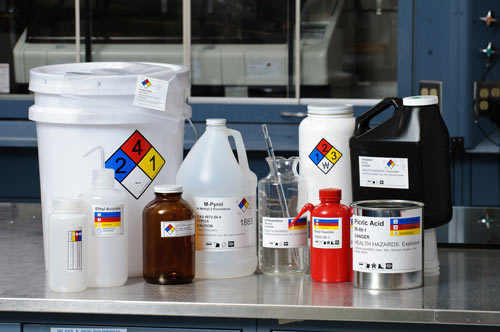
If there’s an emergency, will first responders immediately know that hazardous chemicals are used or stored in your facility?
Will they know if they can work safely in the area using only specialized protective equipment? Will they know if a chemical reacts with water in a dangerous way? Make sure employees are always informed with Right to Know (RTK) Labels.
Critical questions like these in situations that demand snap decisions need to be answered quickly. And they are, without a word spoken, by the National Fire Protection Association (NFPA®) 704 rating system (commonly referred to as the NFPA hazard diamond or fire diamond). The NFPA 704 diamond system alerts firefighters and other emergency response personnel to the health, flammability and reactivity hazards present and special considerations needed to effectively fight a fire, spill or other dangerous situation involving hazardous chemicals.
Explore the background of the NFPA diamond, its colors, numbers and legends, as well as sizing and placement as recommended by the NFPA 704 Standard.[1]
The NFPA diamond alerts emergency responders to the presence of hazardous materials and their potential effects, and helps them plan an appropriate emergency response. It does not identify specific chemicals in the facility or chronic, long-term health hazards as a result of them.
The NFPA 704 diamond system has applications in commercial, industrial and institutional facilities that manufacture, process, use or store hazardous materials. It can also assist engineers as well as plant and safety personnel in taking inventory and evaluating the relative hazards of materials in their facility.[2]
The NFPA diamond has been a recognizable symbol for decades, ever since its creation in 1960.[3] Anyone who works with or near hazardous and potentially dangerous chemicals or materials will most likely have seen the NFPA hazard diamond on building entrances, exterior walls or storage areas. But even when it comes to the general public, the fire diamond is widespread on semi-trucks, propane tanks, train cars and other places where potentially hazardous materials are stored or transported.
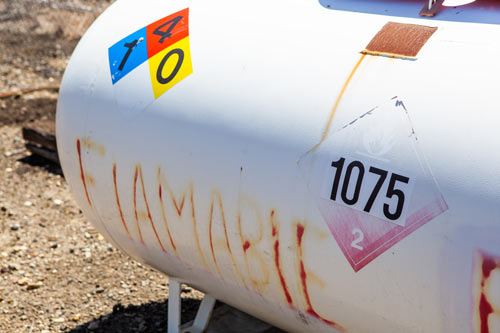
If you’re asking yourself “Do I need to use the fire diamond?”, the answer is: “It depends.” Because it’s a standard, the NFPA 704 system tells you how to label, not when. A local Authority Having Jurisdiction (AHJ), e.g., a fire department, determines requirements by adopting the standard and making it law. So, you should always check with your local AHJ for requirements of where and when to apply NFPA 704 labels.
However, due to its beneficial and simplistic design, many facilities voluntarily place appropriate NFPA fire diamonds on buildings and locations where hazardous materials are stored or used to assist local responders in the event of an emergency and help safeguard against injury—hence its prevalence in many environments.
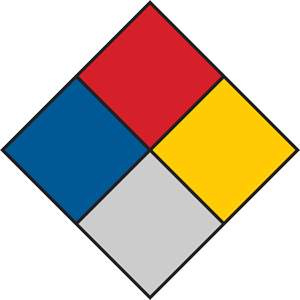
The NFPA 704 system is referred to as the fire diamond due to its square-on-point orientation. It’s comprised of four smaller diamonds, each distinguished by color, placement and symbol (numerical or text). The hazard numbers range from 0 (no hazard) to 4 (severe hazard).
An individual technically competent and experienced in the interpretation of the hazard criteria as set forth in Chapters 5 through 8 of the NFPA 704 standard should perform a hazard evaluation.[1] These qualified individuals determine the ratings for a material by comparing data from the manufacturer‐supplied MSDS to the criteria set forth in the NFPA 704 Standard.
Here’s a snapshot of the hazard degree definition associated with each diamond as laid out by the NFPA 704 Standard[1] as well as potential examples of chemicals that may be associated with each rating. Always consult a chemical’s material safety data sheet (MSDS) when determining ratings.
When looking at the NFPA 704 diamond, the left diamond is blue and relates to the level of hazard to a person’s body. A chemical’s health hazard number indicates the level as to which it can cause personal injury via inhalation, skin or eye contact, or ingestion. It does not include potential injury resulting from fire or explosion, or from chronic long-term exposure.

| 0 | Poses no health hazard, no precautions necessary | Example: peanut oil |
| 1 | Can cause significant irritation | Example: turpentine |
| 2 | Can cause temporary incapacitation or residual injury | Example: ammonia gas |
| 3 | Can cause serious or permanent injury | Example: chlorine gas |
| 4 | Can be lethal | Example: hydrogen cyanide |
The top diamond is red. It communicates to responders a chemical’s flammability hazard, or the degree of susceptibility of a material to burning.
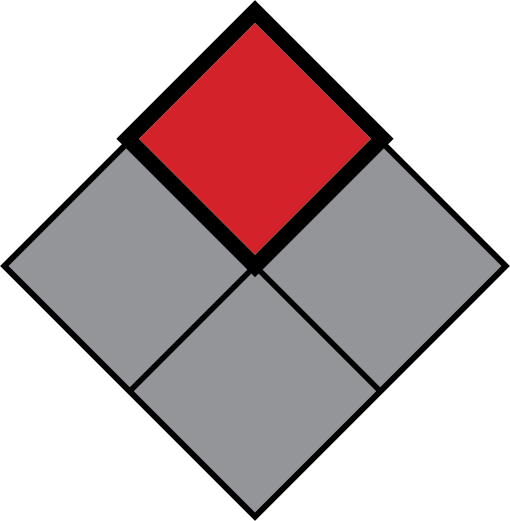
| 0 | Materials that will not burn under typical fire conditions | Example: carbon tetrachloride |
| 1 | Materials that require considerable preheating, under all ambient temperature conditions, before ignition and combustion can occur | Example: ammonia |
| 2 | Must be moderately heated or exposed to relatively high ambient temperature before ignition can occur | Example: paper |
| 3 | Liquids and solids that can be ignited under almost all ambient temperature conditions | Example: acetone |
| 4 | Will rapidly or completely vaporize at atmospheric pressure and normal ambient temperature, or that are readily dispersed in air and burn easily | Example: propane |
When looking at the NFPA fire diamond, the right diamond is yellow and indicates a chemical’s instability hazard. This number details a degree of reaction with ambient air, light or both, and the degree of intrinsic susceptibility of materials to release energy by self-reaction. Responding personnel will use this number to determine if:
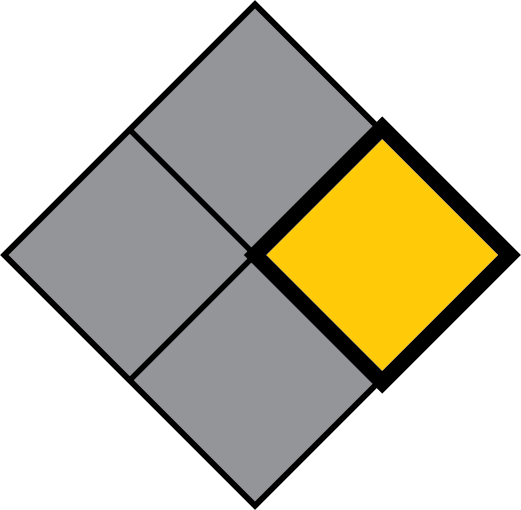
| 0 | Normally stable, even under fire conditions, and not reactive with water | Example: helium |
| 1 | Normally stable, but can become unstable at elevated temperature or pressure | Example: propene |
| 2 | Undergoes violent chemical change at elevated temperature or pressure, and reacts violently or may form explosive mixture with water | Example: potassium |
| 3 | Capable of detonation or explosive decomposition but requires a strong initiating source, must be heated under confinement before initiation, reacts explosively with water or will detonate if severely shocked | Example: hydrogen peroxide |
| 4 | Readily capable of detonation or explosive decomposition at normal temperatures and pressures | Example: trinitrotoluene (TNT) |
The white area can contain one of several special notice symbols defined by the NFPA 704 Standard:
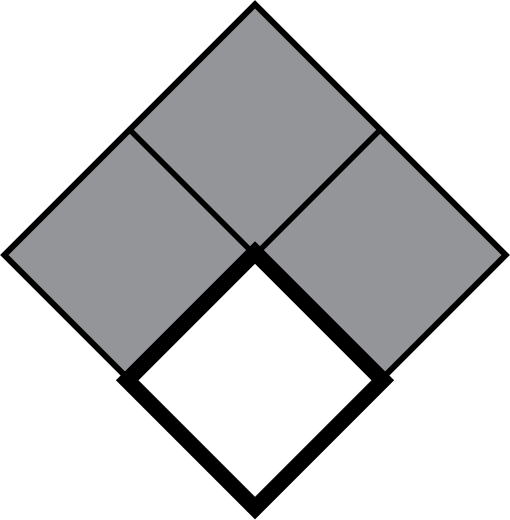
You may see other symbols in the special hazard area, though they are not listed as part of the NFPA 704 Standard. These could include:
When display of the NFPA 704 diamond is a requirement, placement and quantity will be determined by an AHJ. Generally speaking, these guidelines may adhere to the following criteria:
See Chapter 4.3 of NFPA 704 for further guidance.[1]
NFPA 704 diamond size will relate to the minimum distance at which it should be visible, which will be part of an AHJ’s requirements. See Chapter 9 of the NFPA 704 Standard for specific size requirements at certain distances.[1]
When it comes the NFPA fire diamond, rely on the identification leader to help you label the way that works best for you. From pre-printed labels and signs to DIY printing systems, Brady offers a wide range of flexible options to help you follow the NFPA 704 Standard.
Preprinted labels and signs are selectable by size and material, including vinyl, paper, plastic and more, depending on your durability needs. Designed and tested to hold up to harsh environments and be seen on containers and storage areas, they’re a convenient solution for those who want to quickly and easily identify stored hazardous materials and their potential effects.
Ideal for those who need to create custom labels or for those who have a small number of labels to print, the BradyJet J2000 full-color industrial inkjet printer combines the best of durability and flexibility in a single on-demand solution. Plus, premade templates with Brady Workstation printer software take out the guesswork of label design and placement, leaving you to simply enter the information for the container’s contents.
References